Organisational Behaviour Report: M&S, Theories, and Team Dynamics
VerifiedAdded on 2022/12/27
|18
|5262
|2
Report
AI Summary
This report provides a comprehensive analysis of organisational behaviour, using Marks and Spencer (M&S) as a case study. It explores the impact of power, politics, and organisational culture on individual and team performance, examining concepts such as coercive, legitimate, reward, informational, and expert power, as well as various organisational cultures (power, role, task, and person). The report delves into motivation theories, including Maslow's Hierarchy of Needs and Vroom's Expectancy Theory, and assesses how these theories influence behaviour. It also differentiates between effective and ineffective teams, analysing group development and team theories (Tuckman and Belbin) to support the development of effective teams. Furthermore, the report assesses the concepts and philosophies of organisational behaviour, such as path-goal theory, situational theory, and social capital theory and evaluates how these theories and philosophies influence behaviour within the organisation. The report concludes with an evaluation of the impacts of these factors on M&S and offers insights into improving organisational outcomes.
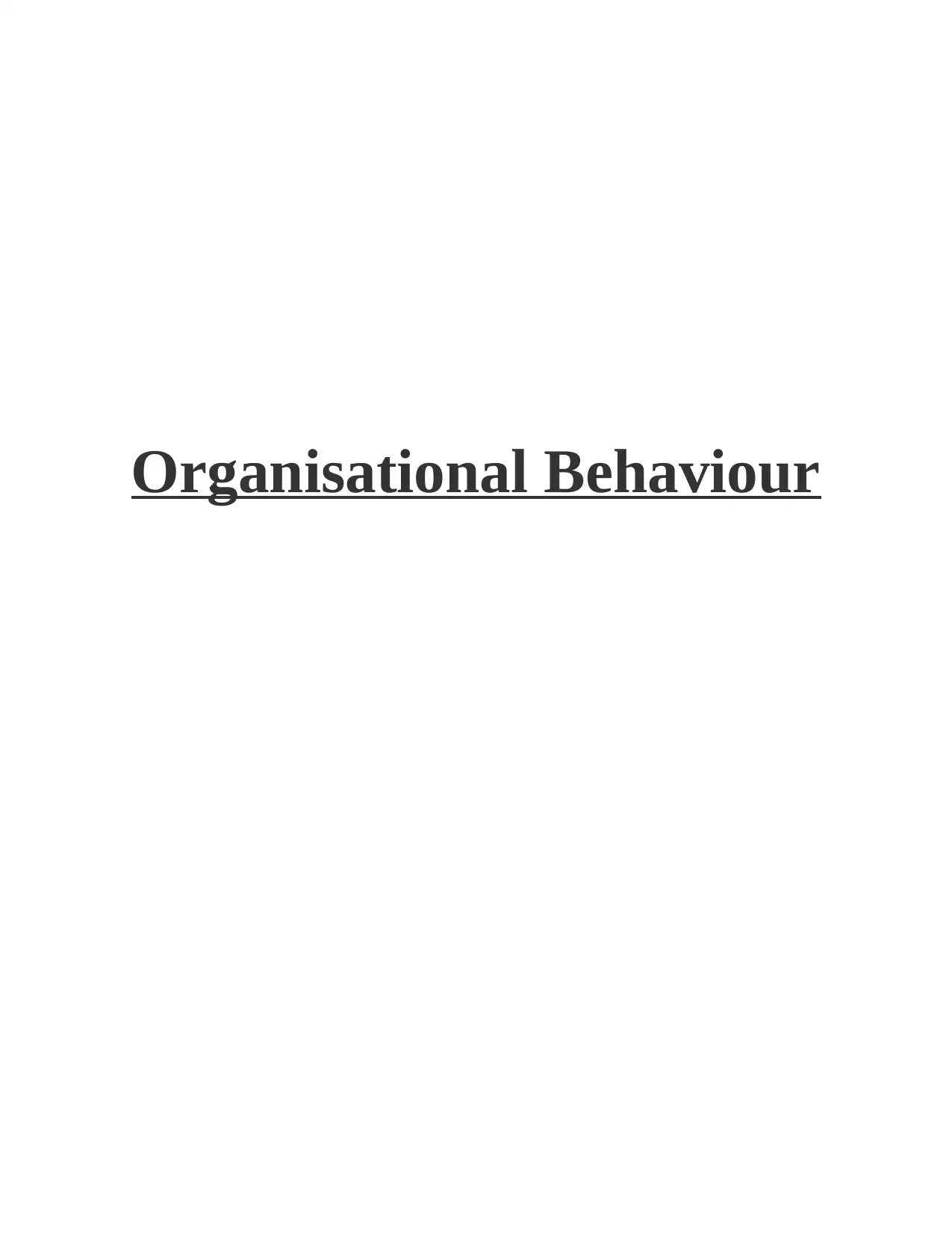
Organisational Behaviour
Paraphrase This Document
Need a fresh take? Get an instant paraphrase of this document with our AI Paraphraser
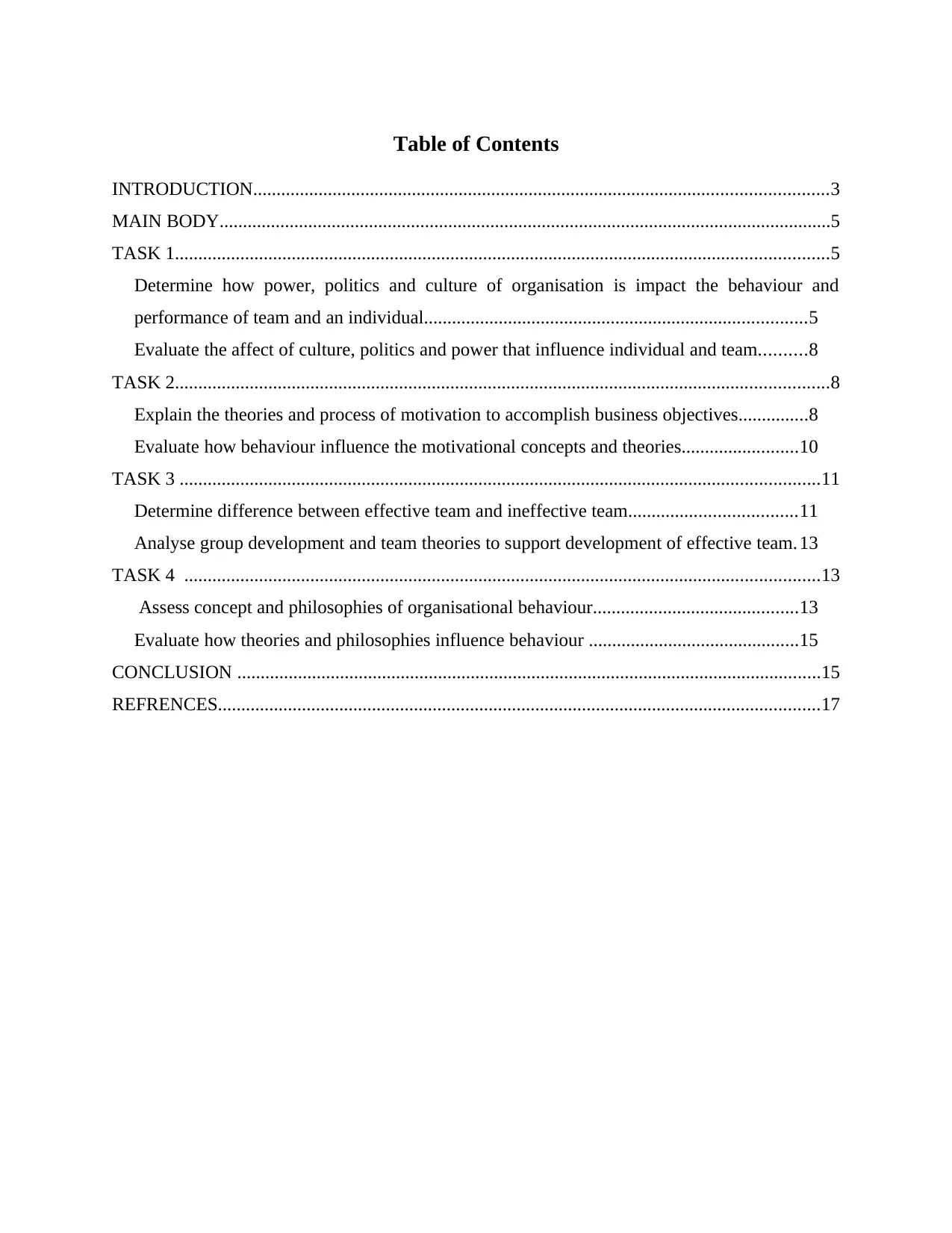
Table of Contents
INTRODUCTION...........................................................................................................................3
MAIN BODY...................................................................................................................................5
TASK 1............................................................................................................................................5
Determine how power, politics and culture of organisation is impact the behaviour and
performance of team and an individual..................................................................................5
Evaluate the affect of culture, politics and power that influence individual and team..........8
TASK 2............................................................................................................................................8
Explain the theories and process of motivation to accomplish business objectives...............8
Evaluate how behaviour influence the motivational concepts and theories.........................10
TASK 3 .........................................................................................................................................11
Determine difference between effective team and ineffective team....................................11
Analyse group development and team theories to support development of effective team. 13
TASK 4 ........................................................................................................................................13
Assess concept and philosophies of organisational behaviour............................................13
Evaluate how theories and philosophies influence behaviour .............................................15
CONCLUSION .............................................................................................................................15
REFRENCES.................................................................................................................................17
INTRODUCTION...........................................................................................................................3
MAIN BODY...................................................................................................................................5
TASK 1............................................................................................................................................5
Determine how power, politics and culture of organisation is impact the behaviour and
performance of team and an individual..................................................................................5
Evaluate the affect of culture, politics and power that influence individual and team..........8
TASK 2............................................................................................................................................8
Explain the theories and process of motivation to accomplish business objectives...............8
Evaluate how behaviour influence the motivational concepts and theories.........................10
TASK 3 .........................................................................................................................................11
Determine difference between effective team and ineffective team....................................11
Analyse group development and team theories to support development of effective team. 13
TASK 4 ........................................................................................................................................13
Assess concept and philosophies of organisational behaviour............................................13
Evaluate how theories and philosophies influence behaviour .............................................15
CONCLUSION .............................................................................................................................15
REFRENCES.................................................................................................................................17
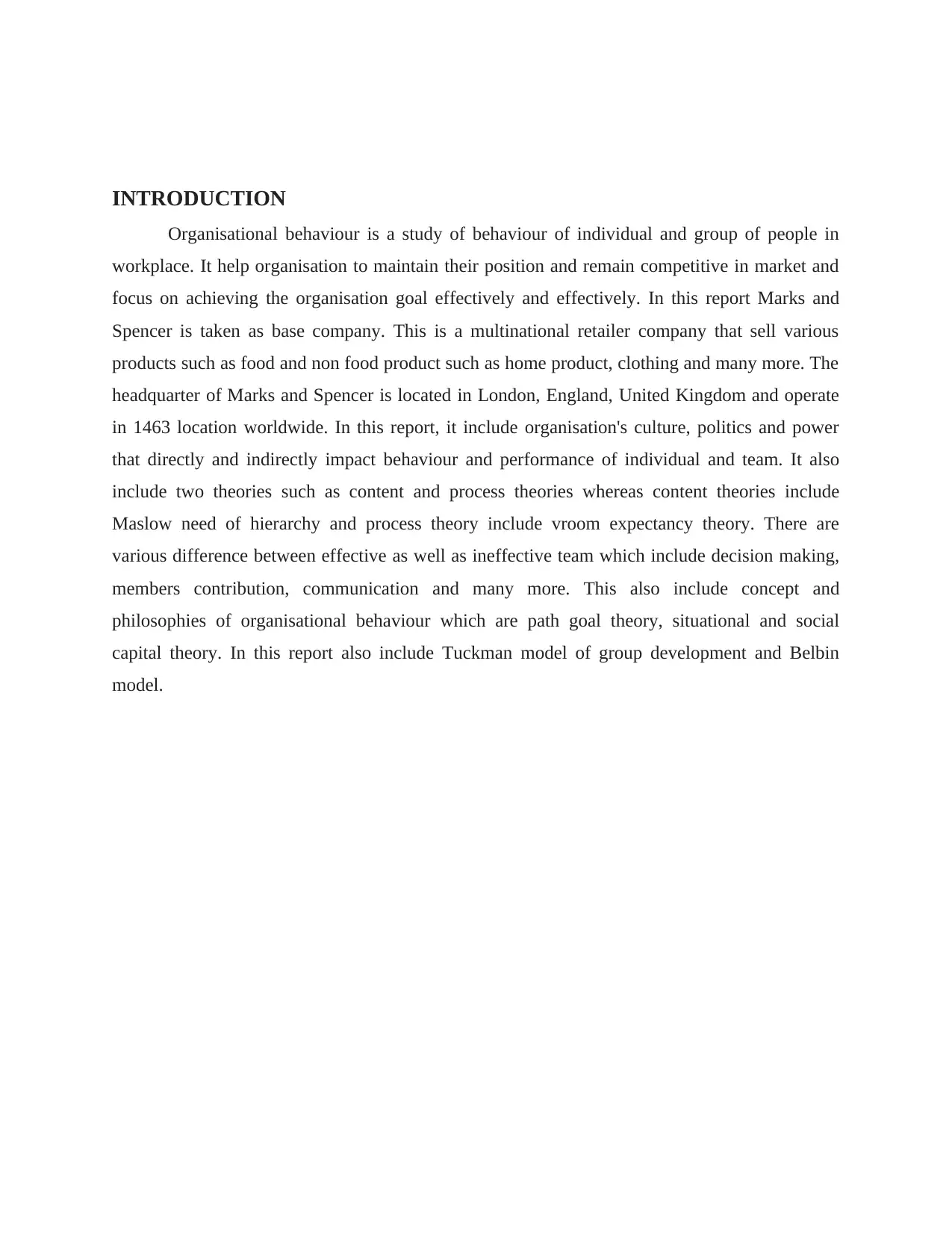
INTRODUCTION
Organisational behaviour is a study of behaviour of individual and group of people in
workplace. It help organisation to maintain their position and remain competitive in market and
focus on achieving the organisation goal effectively and effectively. In this report Marks and
Spencer is taken as base company. This is a multinational retailer company that sell various
products such as food and non food product such as home product, clothing and many more. The
headquarter of Marks and Spencer is located in London, England, United Kingdom and operate
in 1463 location worldwide. In this report, it include organisation's culture, politics and power
that directly and indirectly impact behaviour and performance of individual and team. It also
include two theories such as content and process theories whereas content theories include
Maslow need of hierarchy and process theory include vroom expectancy theory. There are
various difference between effective as well as ineffective team which include decision making,
members contribution, communication and many more. This also include concept and
philosophies of organisational behaviour which are path goal theory, situational and social
capital theory. In this report also include Tuckman model of group development and Belbin
model.
Organisational behaviour is a study of behaviour of individual and group of people in
workplace. It help organisation to maintain their position and remain competitive in market and
focus on achieving the organisation goal effectively and effectively. In this report Marks and
Spencer is taken as base company. This is a multinational retailer company that sell various
products such as food and non food product such as home product, clothing and many more. The
headquarter of Marks and Spencer is located in London, England, United Kingdom and operate
in 1463 location worldwide. In this report, it include organisation's culture, politics and power
that directly and indirectly impact behaviour and performance of individual and team. It also
include two theories such as content and process theories whereas content theories include
Maslow need of hierarchy and process theory include vroom expectancy theory. There are
various difference between effective as well as ineffective team which include decision making,
members contribution, communication and many more. This also include concept and
philosophies of organisational behaviour which are path goal theory, situational and social
capital theory. In this report also include Tuckman model of group development and Belbin
model.
⊘ This is a preview!⊘
Do you want full access?
Subscribe today to unlock all pages.

Trusted by 1+ million students worldwide

Paraphrase This Document
Need a fresh take? Get an instant paraphrase of this document with our AI Paraphraser
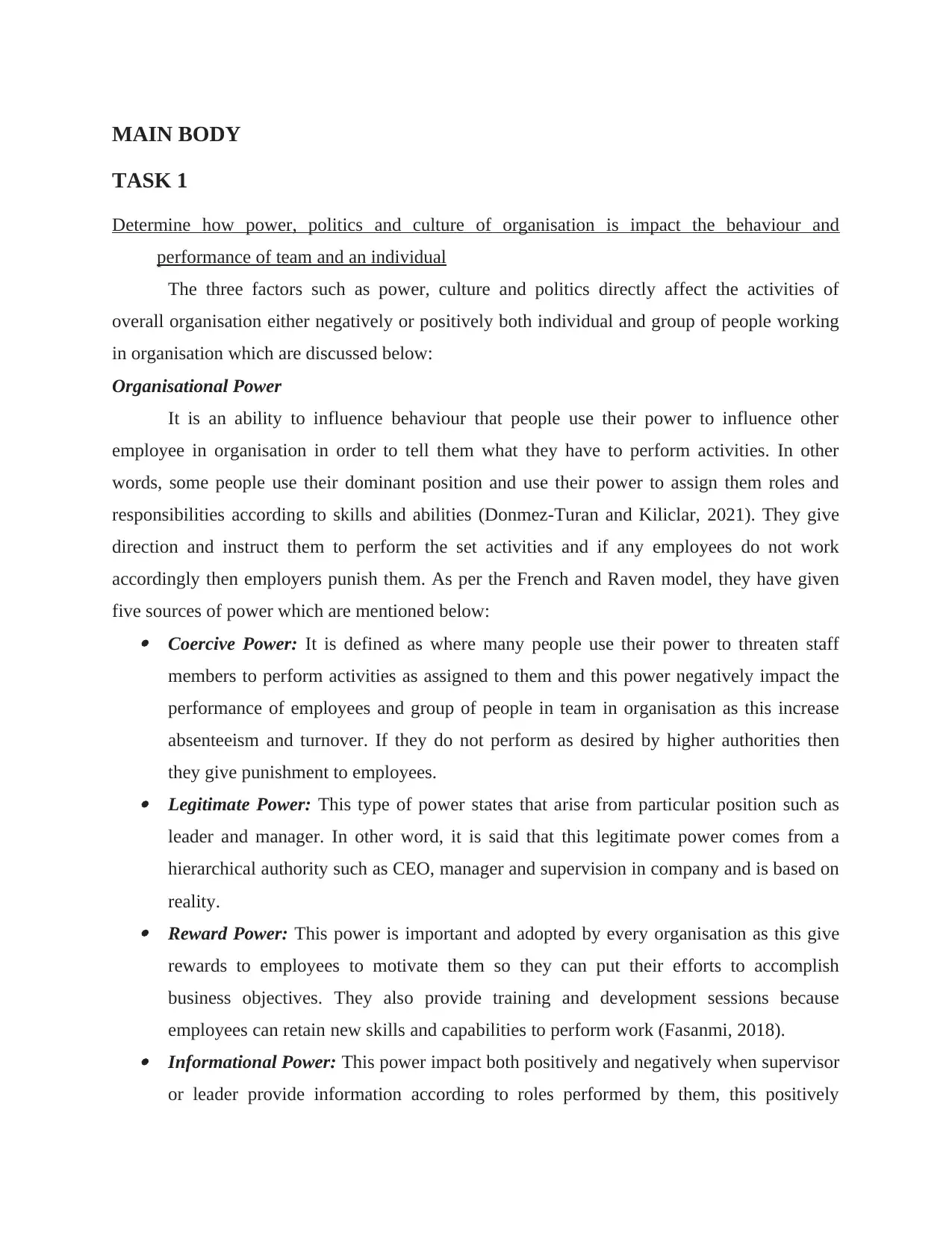
MAIN BODY
TASK 1
Determine how power, politics and culture of organisation is impact the behaviour and
performance of team and an individual
The three factors such as power, culture and politics directly affect the activities of
overall organisation either negatively or positively both individual and group of people working
in organisation which are discussed below:
Organisational Power
It is an ability to influence behaviour that people use their power to influence other
employee in organisation in order to tell them what they have to perform activities. In other
words, some people use their dominant position and use their power to assign them roles and
responsibilities according to skills and abilities (Donmez-Turan and Kiliclar, 2021). They give
direction and instruct them to perform the set activities and if any employees do not work
accordingly then employers punish them. As per the French and Raven model, they have given
five sources of power which are mentioned below: Coercive Power: It is defined as where many people use their power to threaten staff
members to perform activities as assigned to them and this power negatively impact the
performance of employees and group of people in team in organisation as this increase
absenteeism and turnover. If they do not perform as desired by higher authorities then
they give punishment to employees. Legitimate Power: This type of power states that arise from particular position such as
leader and manager. In other word, it is said that this legitimate power comes from a
hierarchical authority such as CEO, manager and supervision in company and is based on
reality. Reward Power: This power is important and adopted by every organisation as this give
rewards to employees to motivate them so they can put their efforts to accomplish
business objectives. They also provide training and development sessions because
employees can retain new skills and capabilities to perform work (Fasanmi, 2018). Informational Power: This power impact both positively and negatively when supervisor
or leader provide information according to roles performed by them, this positively
TASK 1
Determine how power, politics and culture of organisation is impact the behaviour and
performance of team and an individual
The three factors such as power, culture and politics directly affect the activities of
overall organisation either negatively or positively both individual and group of people working
in organisation which are discussed below:
Organisational Power
It is an ability to influence behaviour that people use their power to influence other
employee in organisation in order to tell them what they have to perform activities. In other
words, some people use their dominant position and use their power to assign them roles and
responsibilities according to skills and abilities (Donmez-Turan and Kiliclar, 2021). They give
direction and instruct them to perform the set activities and if any employees do not work
accordingly then employers punish them. As per the French and Raven model, they have given
five sources of power which are mentioned below: Coercive Power: It is defined as where many people use their power to threaten staff
members to perform activities as assigned to them and this power negatively impact the
performance of employees and group of people in team in organisation as this increase
absenteeism and turnover. If they do not perform as desired by higher authorities then
they give punishment to employees. Legitimate Power: This type of power states that arise from particular position such as
leader and manager. In other word, it is said that this legitimate power comes from a
hierarchical authority such as CEO, manager and supervision in company and is based on
reality. Reward Power: This power is important and adopted by every organisation as this give
rewards to employees to motivate them so they can put their efforts to accomplish
business objectives. They also provide training and development sessions because
employees can retain new skills and capabilities to perform work (Fasanmi, 2018). Informational Power: This power impact both positively and negatively when supervisor
or leader provide information according to roles performed by them, this positively

impact behaviour of employees as they information about what they have to perform.
Furthermore, if manager do not provide information then it negatively impact both
behaviour and performance of employees.
Expert Power: It is a power derive from there who have capabilities and competencies to
to do work and this type of power is until when the results are positive (Gou and et. al.,
2020). When employees are properly guided then they give positive outcome and when it
is negative then it adversely impact performance of team and employees both.
In context to Marks and Spencer they use reward power as well as expert power to
motivate employees by giving them various rewards such as perks, financial benefit, training and
development sessions and so on. This help them to achieve organisational goals and run their
business smoothly and efficiently.
Organisational Culture
Organisational culture means practices and values that is informed to all staff members so
they can follow rules, policy and regulation in proper manner. This help them to maintain
positive work environment and can select talented candidates. Some of the organisational
structure which are followed by them to enhance productivity level and increase performance of
organisation which are discussed as follows: Power culture: Power culture refers to the roles and responsibilities of employees to
order to perform their job. Organisation will only focuses on how the work has been done
rather than what employee achieve from that task. Role culture: In this type of culture, managers assigns jobs to their employee according
their skill, qualification and experience to perform the work. Both manager and
employees knows their roles and responsibilities and perform the work according to rules
and policies. Task culture: In this type of culture, people work in a form of teams in order to complete
a task. Both leadership and skills are combined to achieve the task effectively. Person culture: Employees in this culture are not faithful to their organisation and thinks
that they are prior to the business and power lies in their hands. They doesn't do their
duties neither individually nor in a team (Khan and et. al., 2019).
According to Marks and Spencer, they use role culture as this help them to
maintain positive work environment because manager delegate roles and responsibilities as per
Furthermore, if manager do not provide information then it negatively impact both
behaviour and performance of employees.
Expert Power: It is a power derive from there who have capabilities and competencies to
to do work and this type of power is until when the results are positive (Gou and et. al.,
2020). When employees are properly guided then they give positive outcome and when it
is negative then it adversely impact performance of team and employees both.
In context to Marks and Spencer they use reward power as well as expert power to
motivate employees by giving them various rewards such as perks, financial benefit, training and
development sessions and so on. This help them to achieve organisational goals and run their
business smoothly and efficiently.
Organisational Culture
Organisational culture means practices and values that is informed to all staff members so
they can follow rules, policy and regulation in proper manner. This help them to maintain
positive work environment and can select talented candidates. Some of the organisational
structure which are followed by them to enhance productivity level and increase performance of
organisation which are discussed as follows: Power culture: Power culture refers to the roles and responsibilities of employees to
order to perform their job. Organisation will only focuses on how the work has been done
rather than what employee achieve from that task. Role culture: In this type of culture, managers assigns jobs to their employee according
their skill, qualification and experience to perform the work. Both manager and
employees knows their roles and responsibilities and perform the work according to rules
and policies. Task culture: In this type of culture, people work in a form of teams in order to complete
a task. Both leadership and skills are combined to achieve the task effectively. Person culture: Employees in this culture are not faithful to their organisation and thinks
that they are prior to the business and power lies in their hands. They doesn't do their
duties neither individually nor in a team (Khan and et. al., 2019).
According to Marks and Spencer, they use role culture as this help them to
maintain positive work environment because manager delegate roles and responsibilities as per
⊘ This is a preview!⊘
Do you want full access?
Subscribe today to unlock all pages.

Trusted by 1+ million students worldwide
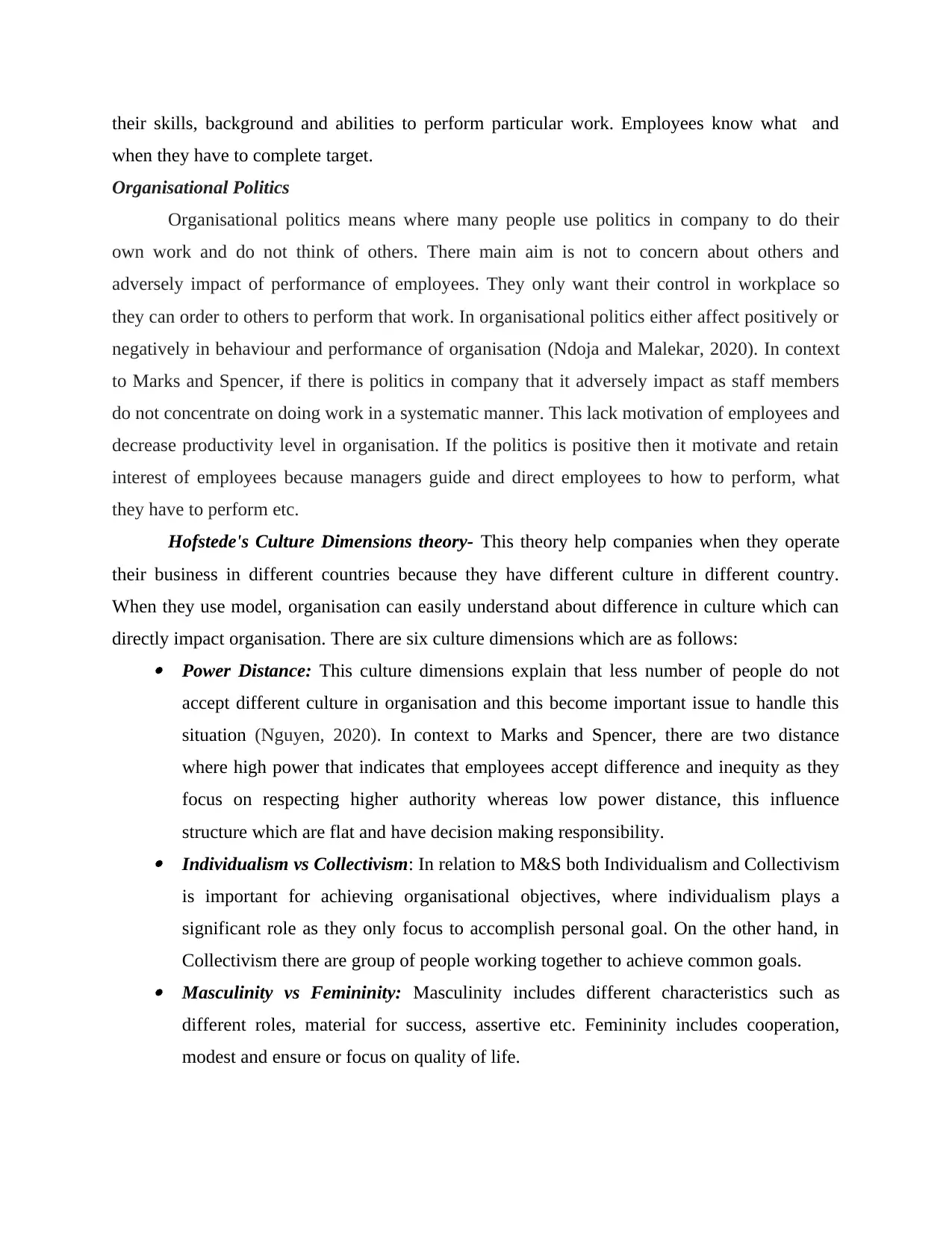
their skills, background and abilities to perform particular work. Employees know what and
when they have to complete target.
Organisational Politics
Organisational politics means where many people use politics in company to do their
own work and do not think of others. There main aim is not to concern about others and
adversely impact of performance of employees. They only want their control in workplace so
they can order to others to perform that work. In organisational politics either affect positively or
negatively in behaviour and performance of organisation (Ndoja and Malekar, 2020). In context
to Marks and Spencer, if there is politics in company that it adversely impact as staff members
do not concentrate on doing work in a systematic manner. This lack motivation of employees and
decrease productivity level in organisation. If the politics is positive then it motivate and retain
interest of employees because managers guide and direct employees to how to perform, what
they have to perform etc.
Hofstede's Culture Dimensions theory- This theory help companies when they operate
their business in different countries because they have different culture in different country.
When they use model, organisation can easily understand about difference in culture which can
directly impact organisation. There are six culture dimensions which are as follows: Power Distance: This culture dimensions explain that less number of people do not
accept different culture in organisation and this become important issue to handle this
situation (Nguyen, 2020). In context to Marks and Spencer, there are two distance
where high power that indicates that employees accept difference and inequity as they
focus on respecting higher authority whereas low power distance, this influence
structure which are flat and have decision making responsibility. Individualism vs Collectivism: In relation to M&S both Individualism and Collectivism
is important for achieving organisational objectives, where individualism plays a
significant role as they only focus to accomplish personal goal. On the other hand, in
Collectivism there are group of people working together to achieve common goals. Masculinity vs Femininity: Masculinity includes different characteristics such as
different roles, material for success, assertive etc. Femininity includes cooperation,
modest and ensure or focus on quality of life.
when they have to complete target.
Organisational Politics
Organisational politics means where many people use politics in company to do their
own work and do not think of others. There main aim is not to concern about others and
adversely impact of performance of employees. They only want their control in workplace so
they can order to others to perform that work. In organisational politics either affect positively or
negatively in behaviour and performance of organisation (Ndoja and Malekar, 2020). In context
to Marks and Spencer, if there is politics in company that it adversely impact as staff members
do not concentrate on doing work in a systematic manner. This lack motivation of employees and
decrease productivity level in organisation. If the politics is positive then it motivate and retain
interest of employees because managers guide and direct employees to how to perform, what
they have to perform etc.
Hofstede's Culture Dimensions theory- This theory help companies when they operate
their business in different countries because they have different culture in different country.
When they use model, organisation can easily understand about difference in culture which can
directly impact organisation. There are six culture dimensions which are as follows: Power Distance: This culture dimensions explain that less number of people do not
accept different culture in organisation and this become important issue to handle this
situation (Nguyen, 2020). In context to Marks and Spencer, there are two distance
where high power that indicates that employees accept difference and inequity as they
focus on respecting higher authority whereas low power distance, this influence
structure which are flat and have decision making responsibility. Individualism vs Collectivism: In relation to M&S both Individualism and Collectivism
is important for achieving organisational objectives, where individualism plays a
significant role as they only focus to accomplish personal goal. On the other hand, in
Collectivism there are group of people working together to achieve common goals. Masculinity vs Femininity: Masculinity includes different characteristics such as
different roles, material for success, assertive etc. Femininity includes cooperation,
modest and ensure or focus on quality of life.
Paraphrase This Document
Need a fresh take? Get an instant paraphrase of this document with our AI Paraphraser
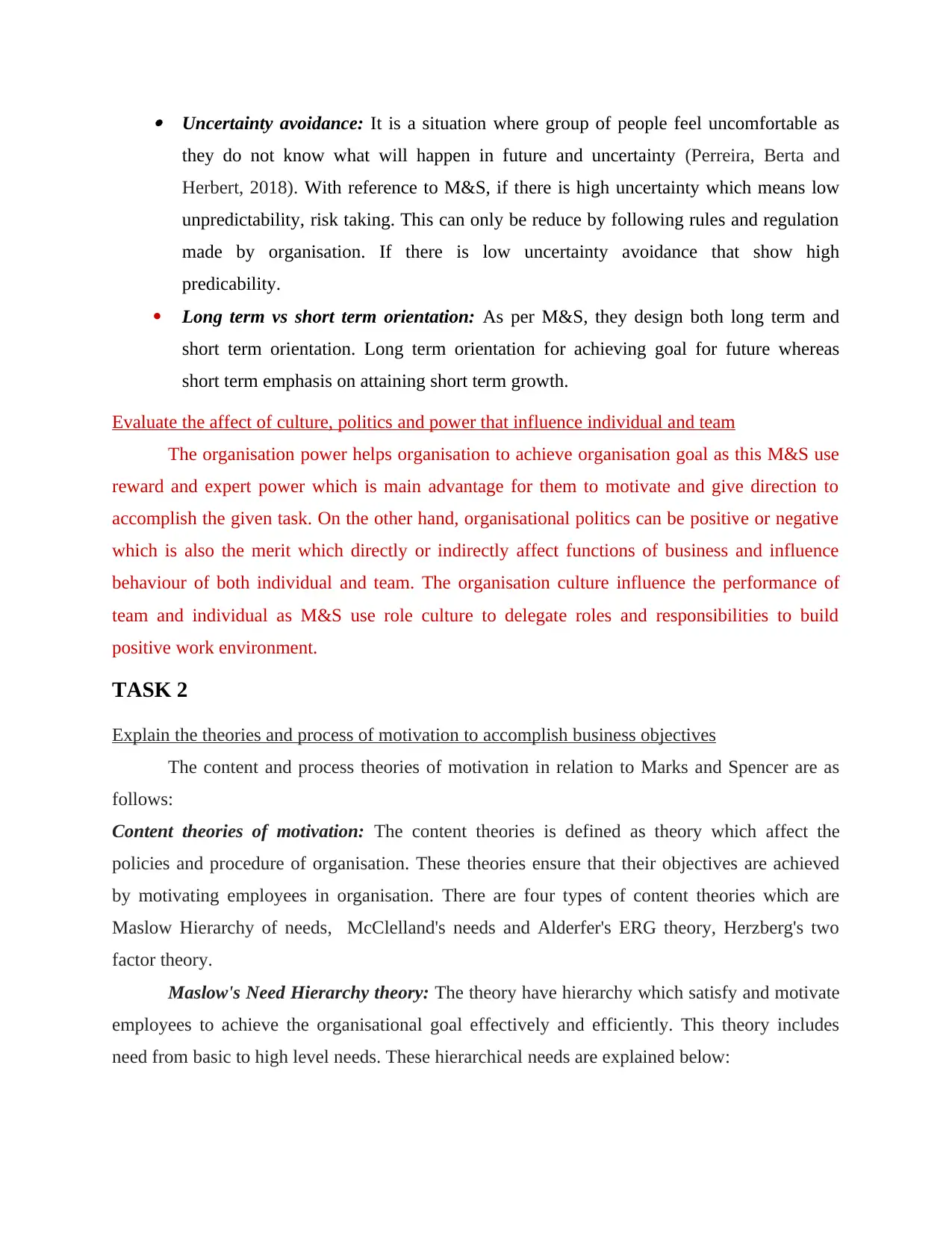
Uncertainty avoidance: It is a situation where group of people feel uncomfortable as
they do not know what will happen in future and uncertainty (Perreira, Berta and
Herbert, 2018). With reference to M&S, if there is high uncertainty which means low
unpredictability, risk taking. This can only be reduce by following rules and regulation
made by organisation. If there is low uncertainty avoidance that show high
predicability.
Long term vs short term orientation: As per M&S, they design both long term and
short term orientation. Long term orientation for achieving goal for future whereas
short term emphasis on attaining short term growth.
Evaluate the affect of culture, politics and power that influence individual and team
The organisation power helps organisation to achieve organisation goal as this M&S use
reward and expert power which is main advantage for them to motivate and give direction to
accomplish the given task. On the other hand, organisational politics can be positive or negative
which is also the merit which directly or indirectly affect functions of business and influence
behaviour of both individual and team. The organisation culture influence the performance of
team and individual as M&S use role culture to delegate roles and responsibilities to build
positive work environment.
TASK 2
Explain the theories and process of motivation to accomplish business objectives
The content and process theories of motivation in relation to Marks and Spencer are as
follows:
Content theories of motivation: The content theories is defined as theory which affect the
policies and procedure of organisation. These theories ensure that their objectives are achieved
by motivating employees in organisation. There are four types of content theories which are
Maslow Hierarchy of needs, McClelland's needs and Alderfer's ERG theory, Herzberg's two
factor theory.
Maslow's Need Hierarchy theory: The theory have hierarchy which satisfy and motivate
employees to achieve the organisational goal effectively and efficiently. This theory includes
need from basic to high level needs. These hierarchical needs are explained below:
they do not know what will happen in future and uncertainty (Perreira, Berta and
Herbert, 2018). With reference to M&S, if there is high uncertainty which means low
unpredictability, risk taking. This can only be reduce by following rules and regulation
made by organisation. If there is low uncertainty avoidance that show high
predicability.
Long term vs short term orientation: As per M&S, they design both long term and
short term orientation. Long term orientation for achieving goal for future whereas
short term emphasis on attaining short term growth.
Evaluate the affect of culture, politics and power that influence individual and team
The organisation power helps organisation to achieve organisation goal as this M&S use
reward and expert power which is main advantage for them to motivate and give direction to
accomplish the given task. On the other hand, organisational politics can be positive or negative
which is also the merit which directly or indirectly affect functions of business and influence
behaviour of both individual and team. The organisation culture influence the performance of
team and individual as M&S use role culture to delegate roles and responsibilities to build
positive work environment.
TASK 2
Explain the theories and process of motivation to accomplish business objectives
The content and process theories of motivation in relation to Marks and Spencer are as
follows:
Content theories of motivation: The content theories is defined as theory which affect the
policies and procedure of organisation. These theories ensure that their objectives are achieved
by motivating employees in organisation. There are four types of content theories which are
Maslow Hierarchy of needs, McClelland's needs and Alderfer's ERG theory, Herzberg's two
factor theory.
Maslow's Need Hierarchy theory: The theory have hierarchy which satisfy and motivate
employees to achieve the organisational goal effectively and efficiently. This theory includes
need from basic to high level needs. These hierarchical needs are explained below:
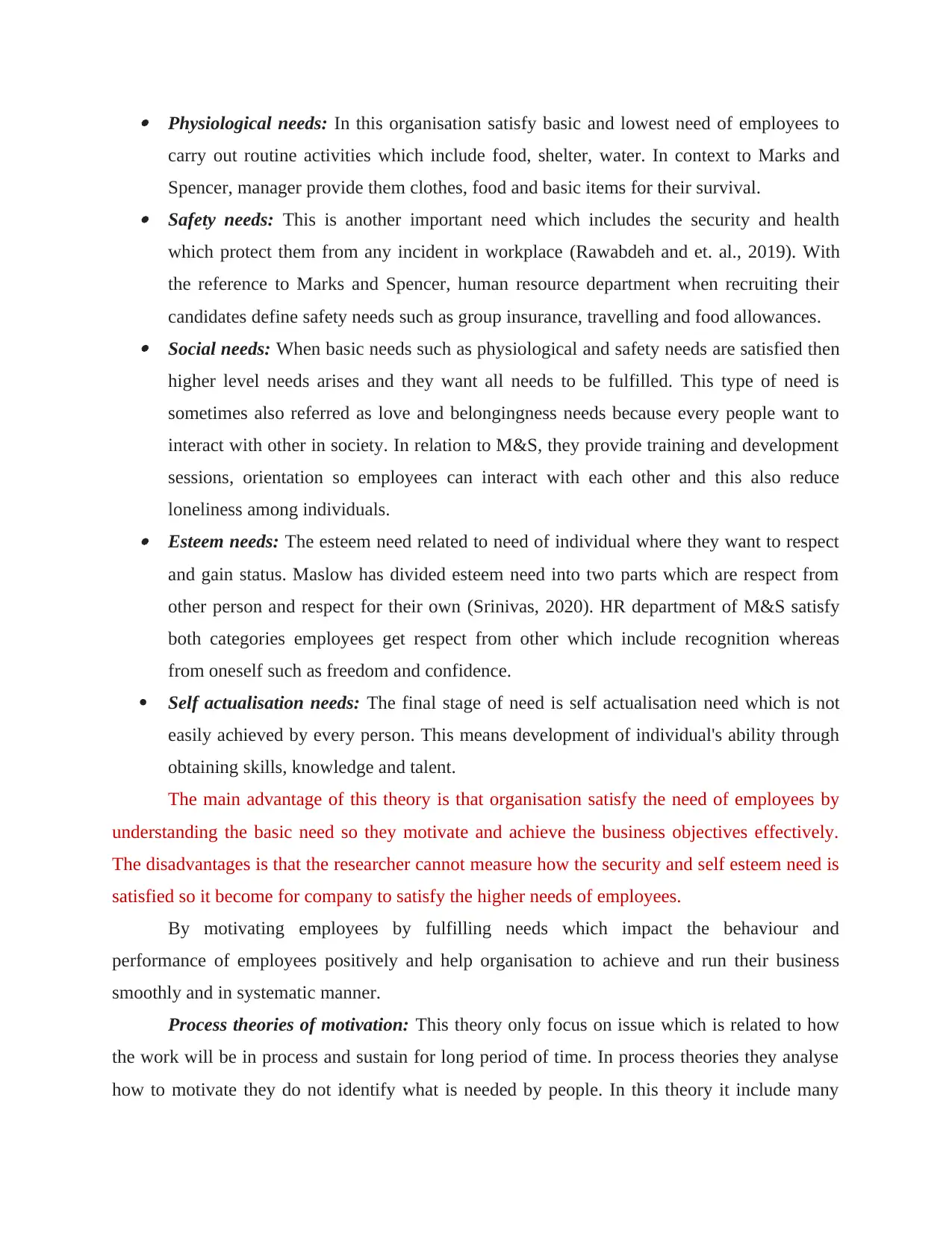
Physiological needs: In this organisation satisfy basic and lowest need of employees to
carry out routine activities which include food, shelter, water. In context to Marks and
Spencer, manager provide them clothes, food and basic items for their survival. Safety needs: This is another important need which includes the security and health
which protect them from any incident in workplace (Rawabdeh and et. al., 2019). With
the reference to Marks and Spencer, human resource department when recruiting their
candidates define safety needs such as group insurance, travelling and food allowances. Social needs: When basic needs such as physiological and safety needs are satisfied then
higher level needs arises and they want all needs to be fulfilled. This type of need is
sometimes also referred as love and belongingness needs because every people want to
interact with other in society. In relation to M&S, they provide training and development
sessions, orientation so employees can interact with each other and this also reduce
loneliness among individuals. Esteem needs: The esteem need related to need of individual where they want to respect
and gain status. Maslow has divided esteem need into two parts which are respect from
other person and respect for their own (Srinivas, 2020). HR department of M&S satisfy
both categories employees get respect from other which include recognition whereas
from oneself such as freedom and confidence.
Self actualisation needs: The final stage of need is self actualisation need which is not
easily achieved by every person. This means development of individual's ability through
obtaining skills, knowledge and talent.
The main advantage of this theory is that organisation satisfy the need of employees by
understanding the basic need so they motivate and achieve the business objectives effectively.
The disadvantages is that the researcher cannot measure how the security and self esteem need is
satisfied so it become for company to satisfy the higher needs of employees.
By motivating employees by fulfilling needs which impact the behaviour and
performance of employees positively and help organisation to achieve and run their business
smoothly and in systematic manner.
Process theories of motivation: This theory only focus on issue which is related to how
the work will be in process and sustain for long period of time. In process theories they analyse
how to motivate they do not identify what is needed by people. In this theory it include many
carry out routine activities which include food, shelter, water. In context to Marks and
Spencer, manager provide them clothes, food and basic items for their survival. Safety needs: This is another important need which includes the security and health
which protect them from any incident in workplace (Rawabdeh and et. al., 2019). With
the reference to Marks and Spencer, human resource department when recruiting their
candidates define safety needs such as group insurance, travelling and food allowances. Social needs: When basic needs such as physiological and safety needs are satisfied then
higher level needs arises and they want all needs to be fulfilled. This type of need is
sometimes also referred as love and belongingness needs because every people want to
interact with other in society. In relation to M&S, they provide training and development
sessions, orientation so employees can interact with each other and this also reduce
loneliness among individuals. Esteem needs: The esteem need related to need of individual where they want to respect
and gain status. Maslow has divided esteem need into two parts which are respect from
other person and respect for their own (Srinivas, 2020). HR department of M&S satisfy
both categories employees get respect from other which include recognition whereas
from oneself such as freedom and confidence.
Self actualisation needs: The final stage of need is self actualisation need which is not
easily achieved by every person. This means development of individual's ability through
obtaining skills, knowledge and talent.
The main advantage of this theory is that organisation satisfy the need of employees by
understanding the basic need so they motivate and achieve the business objectives effectively.
The disadvantages is that the researcher cannot measure how the security and self esteem need is
satisfied so it become for company to satisfy the higher needs of employees.
By motivating employees by fulfilling needs which impact the behaviour and
performance of employees positively and help organisation to achieve and run their business
smoothly and in systematic manner.
Process theories of motivation: This theory only focus on issue which is related to how
the work will be in process and sustain for long period of time. In process theories they analyse
how to motivate they do not identify what is needed by people. In this theory it include many
⊘ This is a preview!⊘
Do you want full access?
Subscribe today to unlock all pages.

Trusted by 1+ million students worldwide
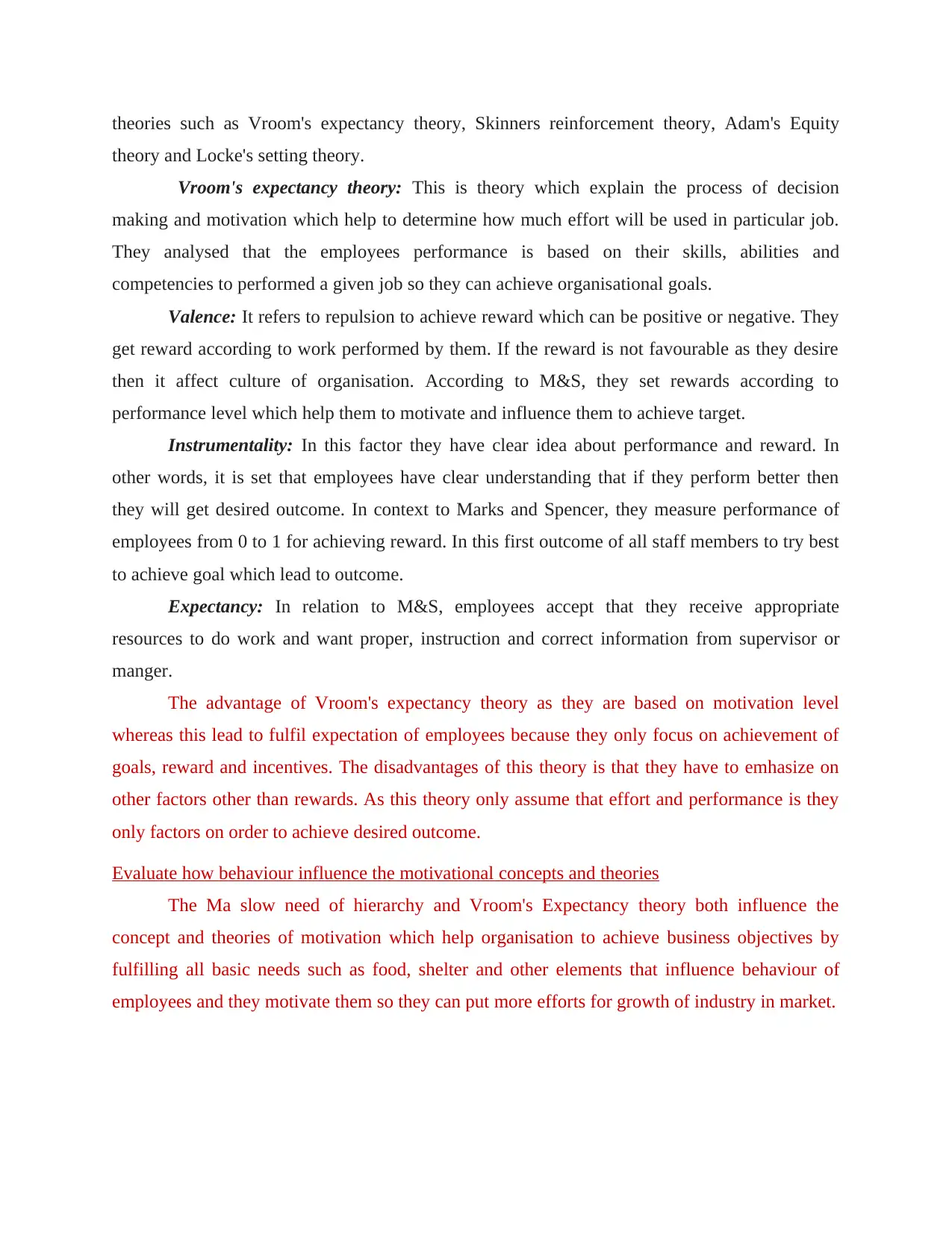
theories such as Vroom's expectancy theory, Skinners reinforcement theory, Adam's Equity
theory and Locke's setting theory.
Vroom's expectancy theory: This is theory which explain the process of decision
making and motivation which help to determine how much effort will be used in particular job.
They analysed that the employees performance is based on their skills, abilities and
competencies to performed a given job so they can achieve organisational goals.
Valence: It refers to repulsion to achieve reward which can be positive or negative. They
get reward according to work performed by them. If the reward is not favourable as they desire
then it affect culture of organisation. According to M&S, they set rewards according to
performance level which help them to motivate and influence them to achieve target.
Instrumentality: In this factor they have clear idea about performance and reward. In
other words, it is set that employees have clear understanding that if they perform better then
they will get desired outcome. In context to Marks and Spencer, they measure performance of
employees from 0 to 1 for achieving reward. In this first outcome of all staff members to try best
to achieve goal which lead to outcome.
Expectancy: In relation to M&S, employees accept that they receive appropriate
resources to do work and want proper, instruction and correct information from supervisor or
manger.
The advantage of Vroom's expectancy theory as they are based on motivation level
whereas this lead to fulfil expectation of employees because they only focus on achievement of
goals, reward and incentives. The disadvantages of this theory is that they have to emhasize on
other factors other than rewards. As this theory only assume that effort and performance is they
only factors on order to achieve desired outcome.
Evaluate how behaviour influence the motivational concepts and theories
The Ma slow need of hierarchy and Vroom's Expectancy theory both influence the
concept and theories of motivation which help organisation to achieve business objectives by
fulfilling all basic needs such as food, shelter and other elements that influence behaviour of
employees and they motivate them so they can put more efforts for growth of industry in market.
theory and Locke's setting theory.
Vroom's expectancy theory: This is theory which explain the process of decision
making and motivation which help to determine how much effort will be used in particular job.
They analysed that the employees performance is based on their skills, abilities and
competencies to performed a given job so they can achieve organisational goals.
Valence: It refers to repulsion to achieve reward which can be positive or negative. They
get reward according to work performed by them. If the reward is not favourable as they desire
then it affect culture of organisation. According to M&S, they set rewards according to
performance level which help them to motivate and influence them to achieve target.
Instrumentality: In this factor they have clear idea about performance and reward. In
other words, it is set that employees have clear understanding that if they perform better then
they will get desired outcome. In context to Marks and Spencer, they measure performance of
employees from 0 to 1 for achieving reward. In this first outcome of all staff members to try best
to achieve goal which lead to outcome.
Expectancy: In relation to M&S, employees accept that they receive appropriate
resources to do work and want proper, instruction and correct information from supervisor or
manger.
The advantage of Vroom's expectancy theory as they are based on motivation level
whereas this lead to fulfil expectation of employees because they only focus on achievement of
goals, reward and incentives. The disadvantages of this theory is that they have to emhasize on
other factors other than rewards. As this theory only assume that effort and performance is they
only factors on order to achieve desired outcome.
Evaluate how behaviour influence the motivational concepts and theories
The Ma slow need of hierarchy and Vroom's Expectancy theory both influence the
concept and theories of motivation which help organisation to achieve business objectives by
fulfilling all basic needs such as food, shelter and other elements that influence behaviour of
employees and they motivate them so they can put more efforts for growth of industry in market.
Paraphrase This Document
Need a fresh take? Get an instant paraphrase of this document with our AI Paraphraser
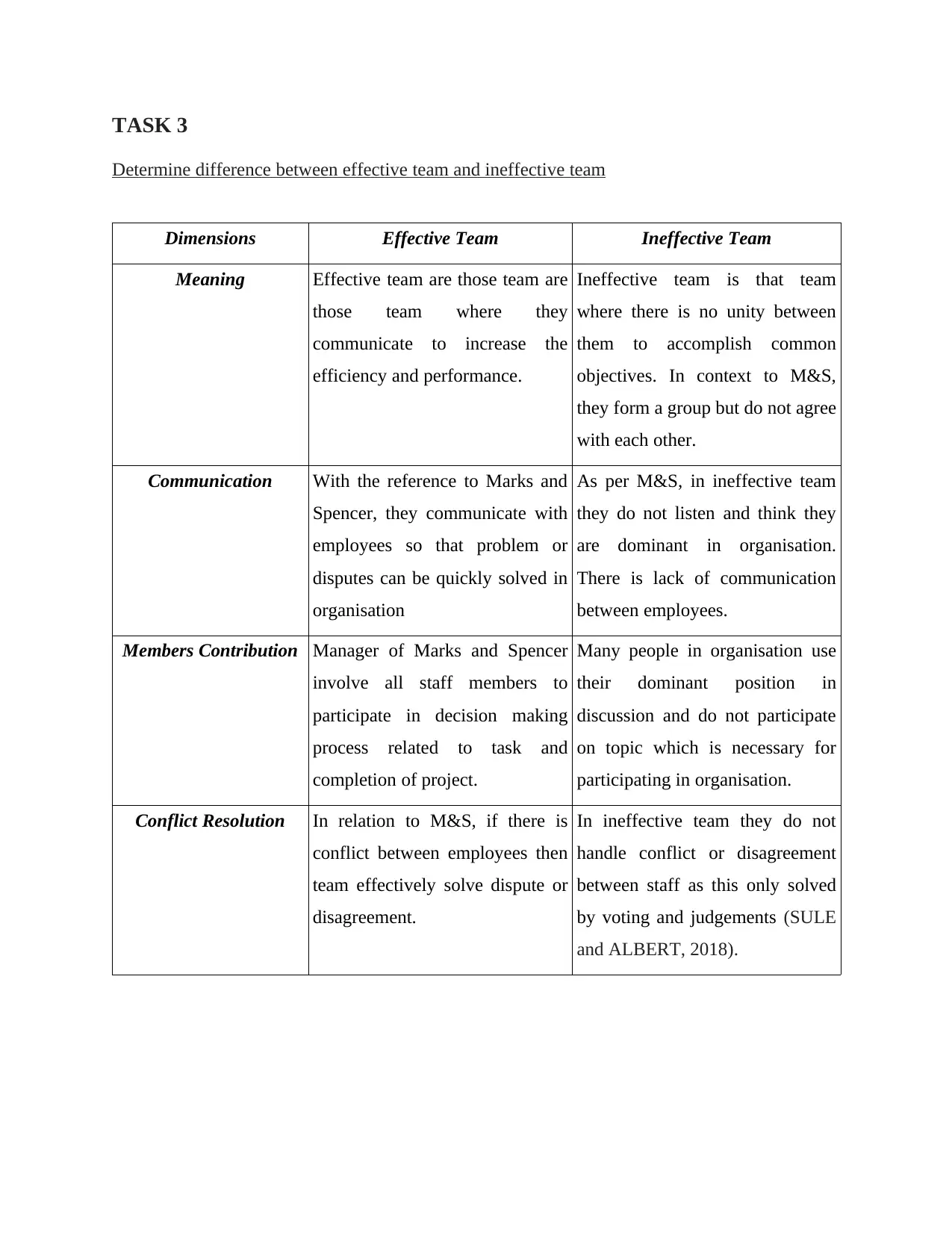
TASK 3
Determine difference between effective team and ineffective team
Dimensions Effective Team Ineffective Team
Meaning Effective team are those team are
those team where they
communicate to increase the
efficiency and performance.
Ineffective team is that team
where there is no unity between
them to accomplish common
objectives. In context to M&S,
they form a group but do not agree
with each other.
Communication With the reference to Marks and
Spencer, they communicate with
employees so that problem or
disputes can be quickly solved in
organisation
As per M&S, in ineffective team
they do not listen and think they
are dominant in organisation.
There is lack of communication
between employees.
Members Contribution Manager of Marks and Spencer
involve all staff members to
participate in decision making
process related to task and
completion of project.
Many people in organisation use
their dominant position in
discussion and do not participate
on topic which is necessary for
participating in organisation.
Conflict Resolution In relation to M&S, if there is
conflict between employees then
team effectively solve dispute or
disagreement.
In ineffective team they do not
handle conflict or disagreement
between staff as this only solved
by voting and judgements (SULE
and ALBERT, 2018).
Determine difference between effective team and ineffective team
Dimensions Effective Team Ineffective Team
Meaning Effective team are those team are
those team where they
communicate to increase the
efficiency and performance.
Ineffective team is that team
where there is no unity between
them to accomplish common
objectives. In context to M&S,
they form a group but do not agree
with each other.
Communication With the reference to Marks and
Spencer, they communicate with
employees so that problem or
disputes can be quickly solved in
organisation
As per M&S, in ineffective team
they do not listen and think they
are dominant in organisation.
There is lack of communication
between employees.
Members Contribution Manager of Marks and Spencer
involve all staff members to
participate in decision making
process related to task and
completion of project.
Many people in organisation use
their dominant position in
discussion and do not participate
on topic which is necessary for
participating in organisation.
Conflict Resolution In relation to M&S, if there is
conflict between employees then
team effectively solve dispute or
disagreement.
In ineffective team they do not
handle conflict or disagreement
between staff as this only solved
by voting and judgements (SULE
and ALBERT, 2018).
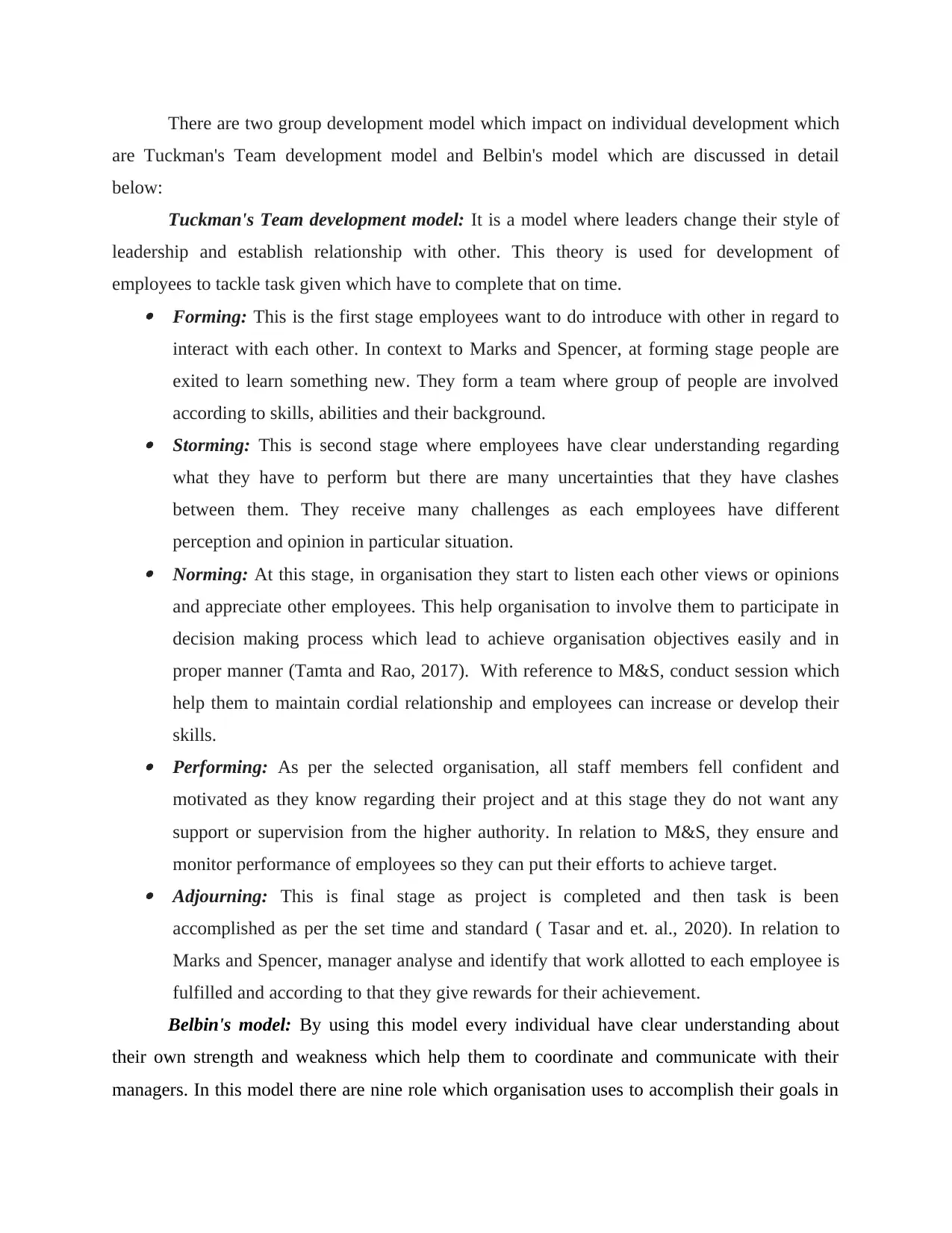
There are two group development model which impact on individual development which
are Tuckman's Team development model and Belbin's model which are discussed in detail
below:
Tuckman's Team development model: It is a model where leaders change their style of
leadership and establish relationship with other. This theory is used for development of
employees to tackle task given which have to complete that on time. Forming: This is the first stage employees want to do introduce with other in regard to
interact with each other. In context to Marks and Spencer, at forming stage people are
exited to learn something new. They form a team where group of people are involved
according to skills, abilities and their background. Storming: This is second stage where employees have clear understanding regarding
what they have to perform but there are many uncertainties that they have clashes
between them. They receive many challenges as each employees have different
perception and opinion in particular situation. Norming: At this stage, in organisation they start to listen each other views or opinions
and appreciate other employees. This help organisation to involve them to participate in
decision making process which lead to achieve organisation objectives easily and in
proper manner (Tamta and Rao, 2017). With reference to M&S, conduct session which
help them to maintain cordial relationship and employees can increase or develop their
skills. Performing: As per the selected organisation, all staff members fell confident and
motivated as they know regarding their project and at this stage they do not want any
support or supervision from the higher authority. In relation to M&S, they ensure and
monitor performance of employees so they can put their efforts to achieve target. Adjourning: This is final stage as project is completed and then task is been
accomplished as per the set time and standard ( Tasar and et. al., 2020). In relation to
Marks and Spencer, manager analyse and identify that work allotted to each employee is
fulfilled and according to that they give rewards for their achievement.
Belbin's model: By using this model every individual have clear understanding about
their own strength and weakness which help them to coordinate and communicate with their
managers. In this model there are nine role which organisation uses to accomplish their goals in
are Tuckman's Team development model and Belbin's model which are discussed in detail
below:
Tuckman's Team development model: It is a model where leaders change their style of
leadership and establish relationship with other. This theory is used for development of
employees to tackle task given which have to complete that on time. Forming: This is the first stage employees want to do introduce with other in regard to
interact with each other. In context to Marks and Spencer, at forming stage people are
exited to learn something new. They form a team where group of people are involved
according to skills, abilities and their background. Storming: This is second stage where employees have clear understanding regarding
what they have to perform but there are many uncertainties that they have clashes
between them. They receive many challenges as each employees have different
perception and opinion in particular situation. Norming: At this stage, in organisation they start to listen each other views or opinions
and appreciate other employees. This help organisation to involve them to participate in
decision making process which lead to achieve organisation objectives easily and in
proper manner (Tamta and Rao, 2017). With reference to M&S, conduct session which
help them to maintain cordial relationship and employees can increase or develop their
skills. Performing: As per the selected organisation, all staff members fell confident and
motivated as they know regarding their project and at this stage they do not want any
support or supervision from the higher authority. In relation to M&S, they ensure and
monitor performance of employees so they can put their efforts to achieve target. Adjourning: This is final stage as project is completed and then task is been
accomplished as per the set time and standard ( Tasar and et. al., 2020). In relation to
Marks and Spencer, manager analyse and identify that work allotted to each employee is
fulfilled and according to that they give rewards for their achievement.
Belbin's model: By using this model every individual have clear understanding about
their own strength and weakness which help them to coordinate and communicate with their
managers. In this model there are nine role which organisation uses to accomplish their goals in
⊘ This is a preview!⊘
Do you want full access?
Subscribe today to unlock all pages.

Trusted by 1+ million students worldwide
1 out of 18
Related Documents
Your All-in-One AI-Powered Toolkit for Academic Success.
+13062052269
info@desklib.com
Available 24*7 on WhatsApp / Email
![[object Object]](/_next/static/media/star-bottom.7253800d.svg)
Unlock your academic potential
Copyright © 2020–2025 A2Z Services. All Rights Reserved. Developed and managed by ZUCOL.

